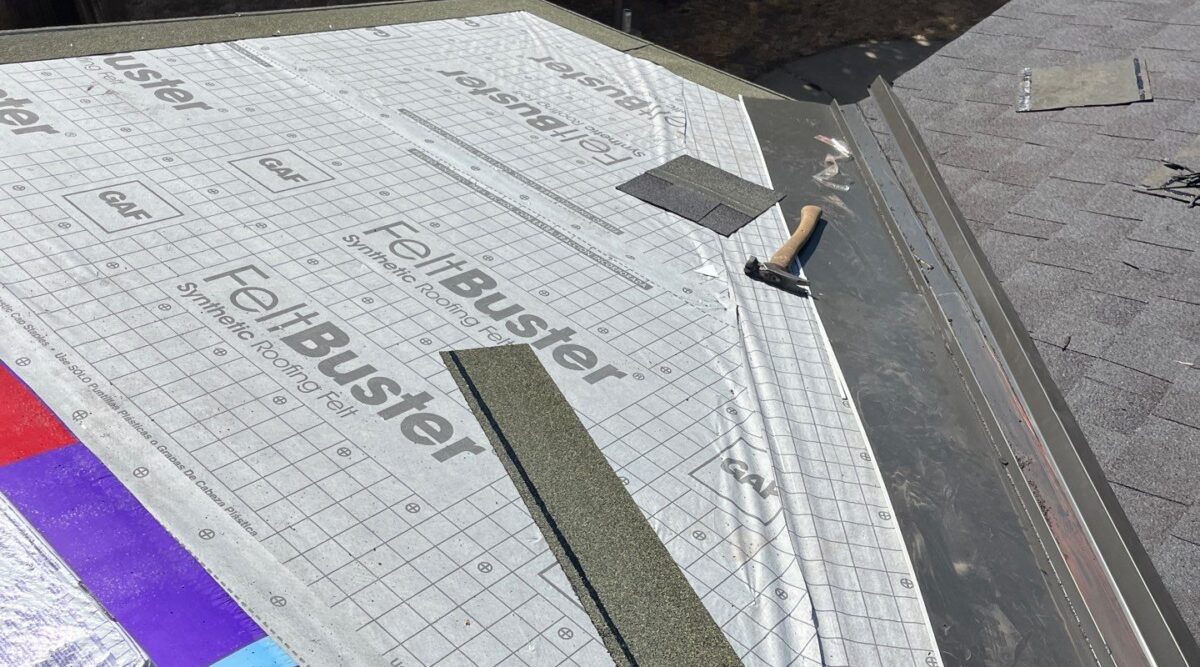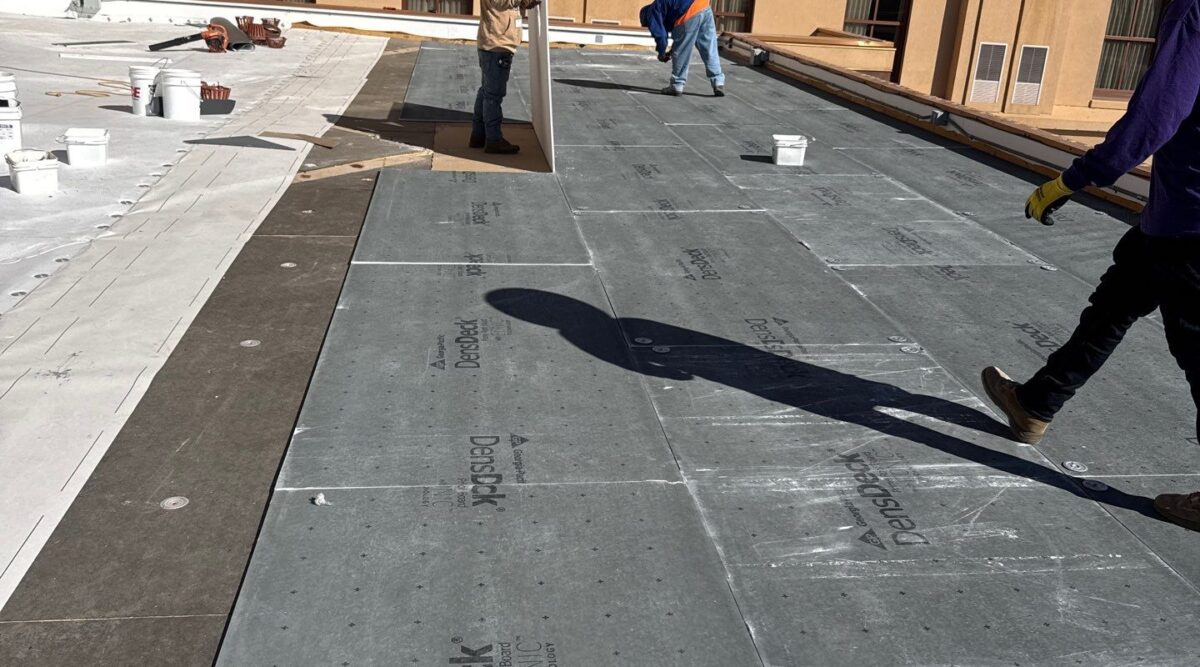3 Roof Underlayment Types – What’s Best for Your Roof?

Your roof underlayment may be out of sight but it’s critical in protecting your home. Acting as the second line of defense beneath shingles, it shields your roof deck from moisture, wind-driven rain, and ice dams. At Grandmark Roofing, we guide homeowners to choose the right underlayment and install it flawlessly, laying the foundation for a long-lasting, high-performance roof.
Key Takeaways
- The three main underlayment types are felt, synthetic, and rubberized asphalt.
- Felt underlayment is cost‑effective but less durable and easily damaged.
- Synthetic underlayment is lightweight, tear-resistant, and suitable for long exposure.
- Rubberized asphalt underlayment gives premium waterproofing in leak-prone zones.
- The right choice improves energy efficiency, warranty eligibility, and roof lifespan.
Why Underlayment Matters to Your Roof
Underlayment lies between the roof deck and outer roofing materials. It acts as a backup barrier against leaks, seals gaps around flashing, and protects the structure when shingles fail. It also smooths the surface for applied roofing and improves thermal performance especially in California’s changing climate [1]. Choosing the correct underlayment and installing it properly means fewer leaks, fewer repairs, and peace of mind.
Types of Underlayment & Why It Matters
Asphalt‑Saturated Felt (Traditional Felt)
A classic choice, felt underlayment comes in #15 and #30 weights. #30 felt is thicker, more tear-resistant, and safer for steep slopes. Felt is budget-friendly but vulnerable to tearing, wrinkling, and water absorption if exposed too long [2]. It’s also slippery and heavier to work with, and many premium shingle warranties require synthetic underlayment instead [3].
Synthetic Underlayment
Made from polypropylene or polyethylene, synthetic underlayment is strong, light, and tear-resistant even in high winds or extended UV exposure. Installation is cleaner and safer thanks to larger roll sizes and slip-resistant surfaces [4]. Many synthetics carry warranties that match or exceed your roof system’s lifespan (often 25–50 years) [6]. However, synthetic is more costly than felt and may trap moisture if attic ventilation isn’t adequate [5].
Rubberized Asphalt (Self-Adhering / Ice & Water Shield)
Best placed around vulnerable areas like valleys, eaves, chimneys, and skylights, this premium underlayment self-seals around fasteners and offers exceptional waterproofing. It’s the most expensive option but ideal for leak-prone zones or regions experiencing ice dams [1].
Choosing the Right Underlayment for Your Home
When advising homeowners, we consider several factors:
- Budget vs. protection: Felt costs less but provides less durability. Synthetic offers long-lasting defense, and rubberized underlayment adds targeted waterproofing.
- Climate & exposure: Synthetic handles UV and moisture better. Rubberized underlayment excels in areas prone to leaks.
- Warranty and code compliance: Premium shingles often require synthetic underlayment for full warranty coverage. Felt may still be allowed in some areas or on specific slopes.
- Safety and installation efficiency: Synthetic is lighter, safer, and faster to install compared to felt rolls.
At Grandmark Roofing, we typically recommend synthetic underlayment as a baseline, combined with self-adhering rubberized products at valleys and penetrations. This approach balances performance, longevity, and homeowner peace of mind.

Real Homeowner Success Story
A Fresno homeowner originally chose felt underlayment to save on cost. During a storm, wind peeled back shingles exposing wrinkled felt underneath and water entered their attic. We replaced the felt with synthetic underlayment, installed premium shingles, and sealed all edges. The home has been leak-free, energy-efficient, and reliably protected ever since.
Tips for Underlayment Longevity & Performance
- Install underlayment before bad weather hits; it degrades quickly if exposed too long. Synthetics can often withstand until roofing materials arrive.
- Follow overlap and fastening guidelines especially on low-slope or complex roofs [5].
- Pair synthetic underlayment with proper attic ventilation to prevent moisture trapping.
- Add rubberized underlayment around valleys, chimneys, and eaves for extra waterproofing.
- Always check local codes some jurisdictions still require felt on steep slopes or built-up roofs.
Want to Make Sure Your Roof Is Built With the Best Underlayment?
Underlayment may be unseen, but it’s essential to long-term roof performance. The right underlayment provides crucial waterproofing, improved insulation, and extended lifespan. At Grandmark Roofing, we help you choose intelligent solutions installing premium underlayment with professional care to build value and trust into every new roof.
Schedule your free, no-pressure roof inspection and underlayment consultation with Grandmark Roofing today. Contact us today to protect your home from the inside out.
FAQs
Synthetic is lighter, stronger, and more UV- and moisture-resistant. Most premium shingle warranties require synthetic underlayment for full coverage.
- https://www.thespruce.com/roofing-underlayment-types-5324864
- https://www.mightydogroofing.com/blog/what-is-roof-underlayment
- https://www.owenscorning.com/en-us/roofing/blog/synthetic-vs-felt-roofing-underlayment-pros-cons
- https://worthouse.com/understanding-roof-underlayment-types-2/
- https://www.decra.com/pro/understanding-roof-underlayment-1
- https://www.westernstatesmetalroofing.com/blog/synthetic-roof-underlayment-types
